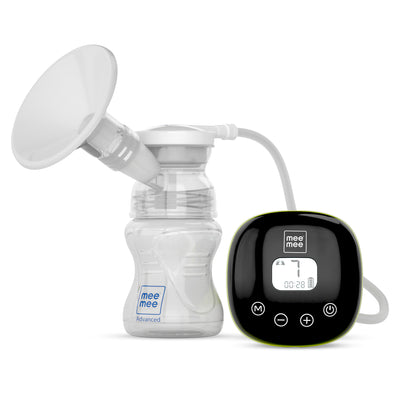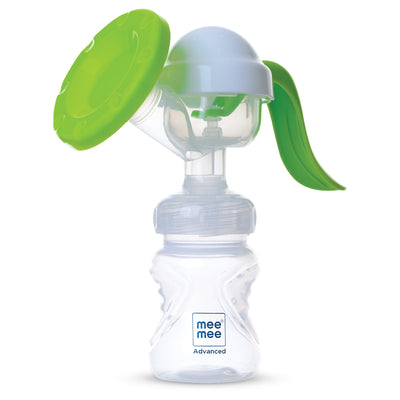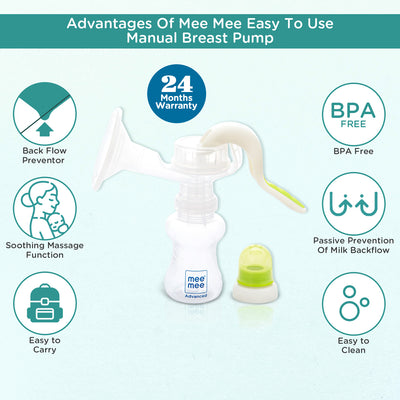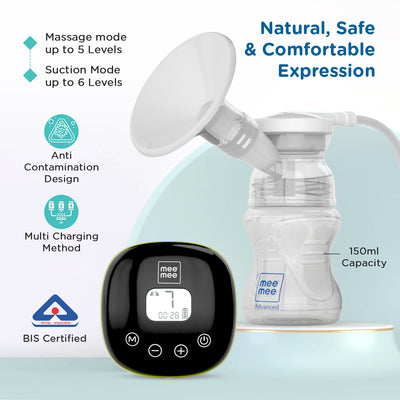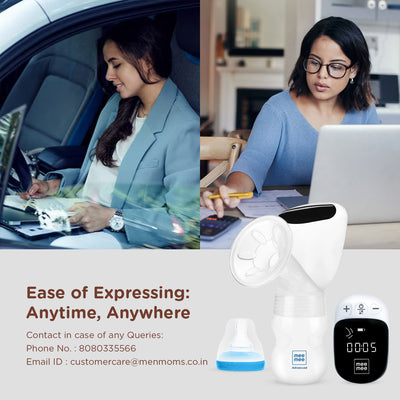A. What is a Breast Pump?
A breast pump is an electric or manual pump that produces suction to imitate a baby's sucking motion and express milk from the breasts. A breast pump assists you in expressing breast milk from your breasts. You can store the milk and use it later to feed your baby. Pumping can ease discomfort and pressure due to breast engorgement or plugged milk ducts.
B. Why do moms choose to pump breast milk?
Pumping enables mothers to give breast milk even when they are not with their baby, ensuring a steady supply and allowing other caregivers to be involved in feeding. Mothers pump breast milk for numerous reasons, such as supporting working mothers, regulating low milk supply, treating medical needs, and increasing convenience. Pumping can assist mothers in building and sustaining a good milk supply.
C. Types of Breast Pumps: Electric vs. Manual
1. Electric Breast Pump
Electric breast pumps utilize a motor to produce suction, replicating the baby's pattern of feeding to express milk. Electric pumps usually have a control panel through which you can adjust the suction level and speed. There are electric pumps that provide multi-user operation but suggest using an accessory kit for each user to ensure cleanliness.
Types: Single vs. Double Electric Breast Pump
Single breast pumps tend to be lighter, smaller, and less expensive than double breast pumps. Single pumps tend to have fewer parts, making them easy to clean and maintain. you can pump one breast while nursing on the other, so you don't produce too much milk.
A double electric breast pump tends to be more effective and can pump milk from both breasts at the same time, which saves time and may also produce more milk than a single pump. This is a favorite among mothers who must pump frequently, particularly if they are going back to work or have hectic lifestyles. Double pumps are efficient and good mimics of natural feeding.
2. Manual Breast Pump
A manual breast pump employs hand-powered suction to induce milk flow. A manual pump requires a little extra effort from you, and each pumping session can last a while. It also doesn't use electricity or batteries to function and is easily portable.
- Different styles of manual pumps.
Manual breast pumps come in a few different types, each designed to suit different needs, comfort preferences and usage styles
- Lever-Style Manual Pump
- Squeeze/Trigger Pump
- Silicone Suction Pump
- Double Manual Pumps
D. Key Differences Between Electric and Manual Breast Pumps
| Feature | Electric Breast Pump | Manual Breast Pump |
|---|---|---|
| Power Source | Requires electricity (battery or AC power) | No power source needed; hand-operated |
| Mechanism | Motor-driven for pumping | Hand-operated with a lever or pump mechanism |
| Portability | Less portable, may be larger and require charging | Highly portable, lightweight, and easy to carry |
| Effort | Requires less effort from the user | Requires more effort from the user |
| Efficiency | Generally faster and more effective | Can be slower and may require more time for pumping |
| Adjustability | Offers adjustable suction levels and modes | Limited or no adjustable suction levels |
| Cost | Typically, more expensive | Typically, less expensive |
| Noise Level | Can be louder, but quieter models are available | Very quiet, discreet pumping |
| Double Pumping | Often has double-pumping capabilities (both breasts at once) | Typically, single-pumping only (one breast at a time) |
| Maintenance | May have more components and require more cleaning | Fewer parts, easier to clean and maintain |
| Ideal For | Regular or exclusive pumping, frequent use | Occasional use, travel, or as a backup pump |
E. Pros and Cons:
1. Electric Breast Pumps
Pros: Electric pumps are quicker and can pump both breasts simultaneously, saving time and effort, particularly for mothers who have to pump frequently or solely. Most electric pumps have adjustable suction and massage modes for a comfortable and personalized pumping experience. They possess hand-free operation, Electric pumps are quicker, enabling mothers to pump and store more milk within a shorter period of time.
Cons: Electric pumps are more costly than manual pumps, they need power sources Some electric pumps can be loud, possibly disrupting the quietness of the surroundings. They might have more parts to clean and maintain than manual pumps. Some electric pumps can be set to higher suction levels, possibly causing over-pumping and more than necessary milk production.
2. Manual Breast Pumps
Pros: Manual pumps are cheaper compared to electric pumps. They are light and portable, which makes them suitable for travel. They don't need any power source, you can also regulate the pressure and pumping rhythm, which is more comfortable and effective according to some mothers.
Cons: It takes longer and is fatiguing for your hands, particularly when pumping frequently. They permit single breast pumping; they might not stimulate let-down or empty the breasts as well as electric pumps.
F. Who should choose an Electric Breast Pump?
An electric breast pump is best suited for mothers who pump frequently or solely like working mothers, busy mothers with little time for pumping, or mothers who need to build or sustain a high milk supply. They provide speed, efficiency, and hands-free convenience and are thus a convenient option for frequent pumping.
G. Who Should Choose a Manual Breast Pump?
A manual breast pump is for mothers who pump occasionally, are on a budget, or prefer a light, portable pump. Manual pumps consist of few parts and are less complicated to clean than electric pumps. They are also ideal for mothers who wish to eliminate the use of batteries or a plug.
H. FAQs About Breast Pumps and Breast Pumping:
1) Which breast pump is better for increasing milk supply?
If you need to stimulate your milk supply in the first five days postpartum, you may use a double electric breast pump with initiation technology. electric breast pumps with 2-Phase Expression technology. Express more milk more efficiently and faster.
2) Can I use both electric and manual pumps?
Yes, you can definitely use both the electric and the manual breast pumps. They have different functions and can be combined depending on your pumping needs and your preferences. Electric pumps are usually ideal for frequent or exclusive pumping, whereas manual pumps are wonderful for occasional pumping, travel, or as a second pump. By knowing the advantages of each type of pump, you will be able to devise a pumping plan that will be most suited to your individual needs and your way of life.
3) Which pump is best for first-time moms?
The top-rated breast pump is Me n Moms, rated highest by over 2,100 moms who commend its effectiveness, comfort and simplicity. Moms prefer such as a backup wearable breast pump
4) Are electric breast pumps safe to use?
Yes, it's usually safe to use an electric breast pump, provided it is used properly and cleaned well. Still, do be mindful of possible risks and take precautions regarding safe use and sanitation to avoid problems.
5) How long does a pumping session take?
A pumping session, particularly when pumping both breasts at once, tends to last around 15 to 20 minutes. The actual length, however, will depend on personal variables and the pumping routine. Certain people will require longer sessions, particularly in the initial days of pumping or if attempting to create a robust milk supply.
6) Do electric breast pumps hurt?
No, electric breast pumps shouldn't hurt when properly used. If it hurts or stings, it's usually a sign that the pump settings or flange size isn't suitable for you, or that your nipples require more TLC.
7) Are manual pumps hard to use?
Manual pumps are usually easy to use, especially for single pumping or in cases where electricity is not accessible. Manual pumps are also light, portable, and require no complicated setup or adjustments. They are simply plugged into the breast and hand-operated.
8) Can pumping increase breast milk?
pumping can enhance breast milk supply, particularly when done strategically. Pumping following nursing or between nursings assists with ensuring your breasts are emptied fully, signaling your body to make more milk. Pumping frequently, particularly within the initial weeks following birth, can establish a strong milk supply.
9) Is it OK to breast pump everyday?
Yes, it is usually fine and in many cases is even recommended to breast pump daily, particularly during the initial weeks of your baby's life in order to develop and sustain a proper milk supply. Pumping frequency will vary based on your baby's needs and the amount of milk that you're making.
10) What are the side effects of breast pumping?
Some possible side effects of breast pumping are sore or traumatized nipples, engorgement, clogged ducts, mastitis, and diminished milk supply when not used appropriately. Breast pumping can traumatize the nipples and breast tissue.
11) Is pumped breast milk as good as breastfeeding?
Yes, expressed milk is as nutritious and healthy for babies as direct breastfeeding. Both ways offer the same necessary nutrients and antibodies that aid in the growth and protection of the baby.
I. Conclusion: Which One is Right for You?
Picking the ideal breast pump will play a significant role in your breastfeeding experience. How to choose the ideal breast pump relies on a few determinative factors—such as the frequency you expect to pump, lifestyle, level of comfort you want, and affordability. familiarizing yourself with electric, manual, portable, hands-free, and wearable pumps' differences can aid you in knowing which best suits your situation.
Helping moms decide which pump suits their lifestyle and needs.
Choosing a breast pump based on your needs and daily schedule is critical. If you intend to pump several times a day, then a double electric pump would be the most appropriate since it is efficient and time-saving. A manual pump can be adequate for occasional use because it is inexpensive and portable. opt for lightweight, compact ones or those that have rechargeable batteries. Consider portability, noise output, cleanliness, and customizable settings to achieve the ultimate fit.


